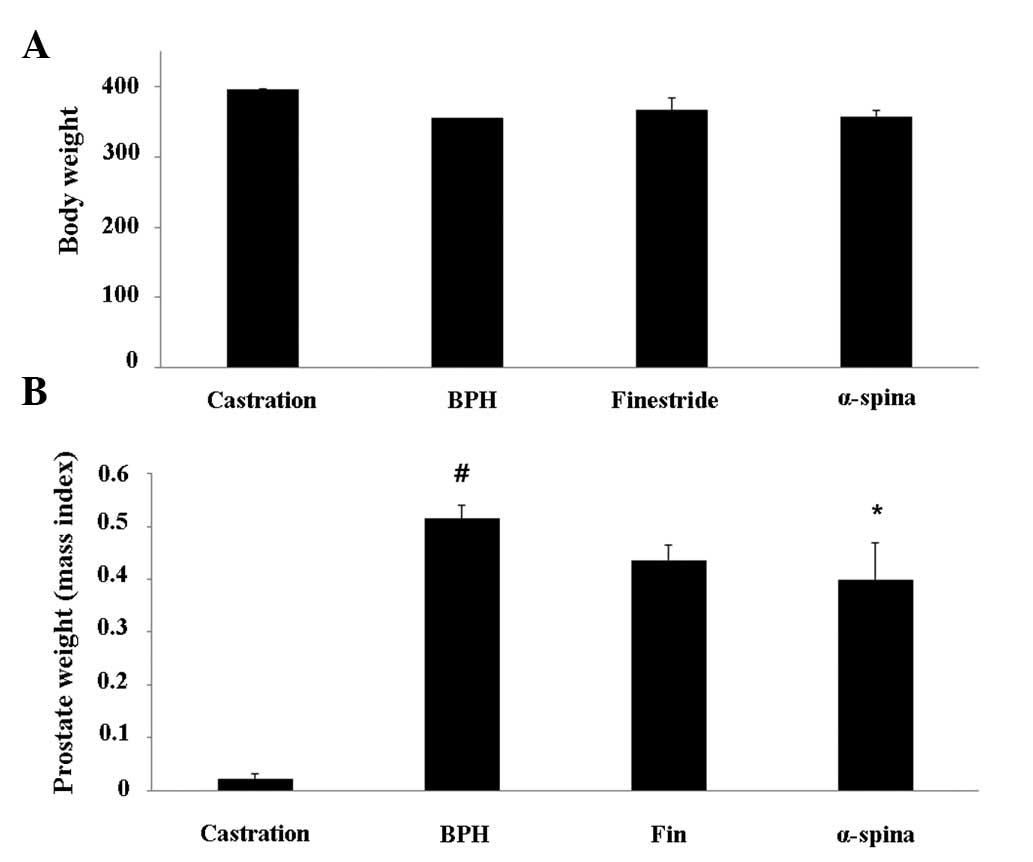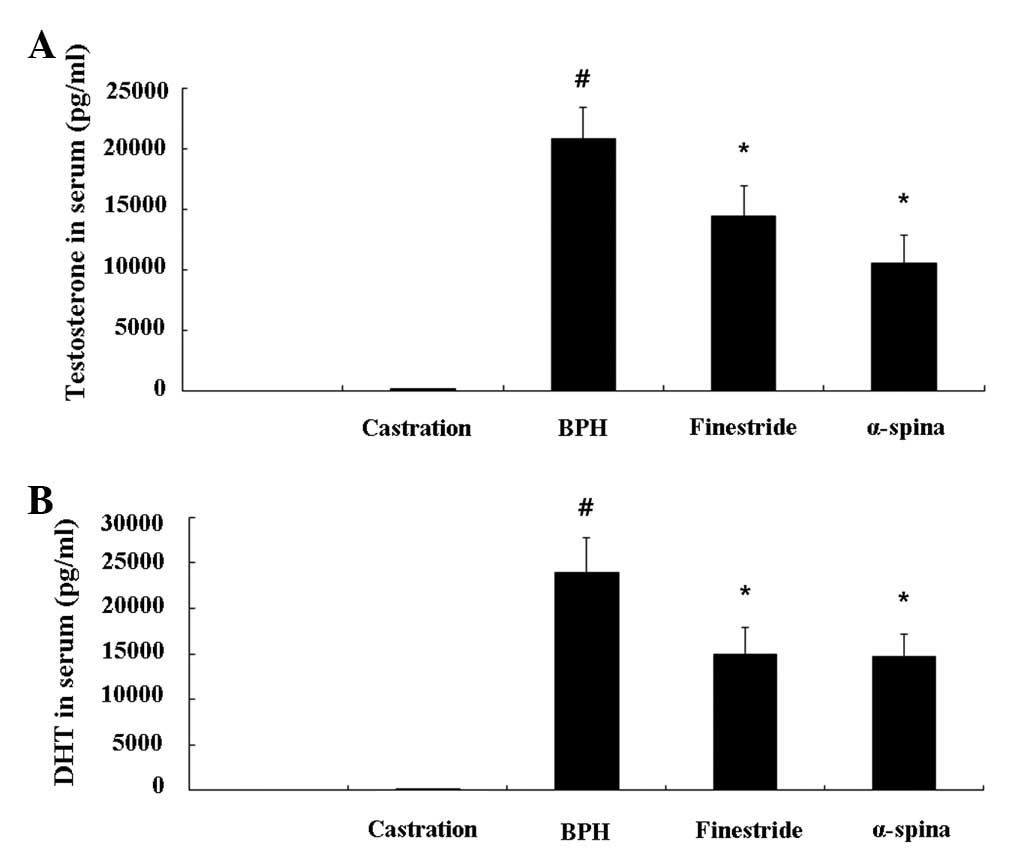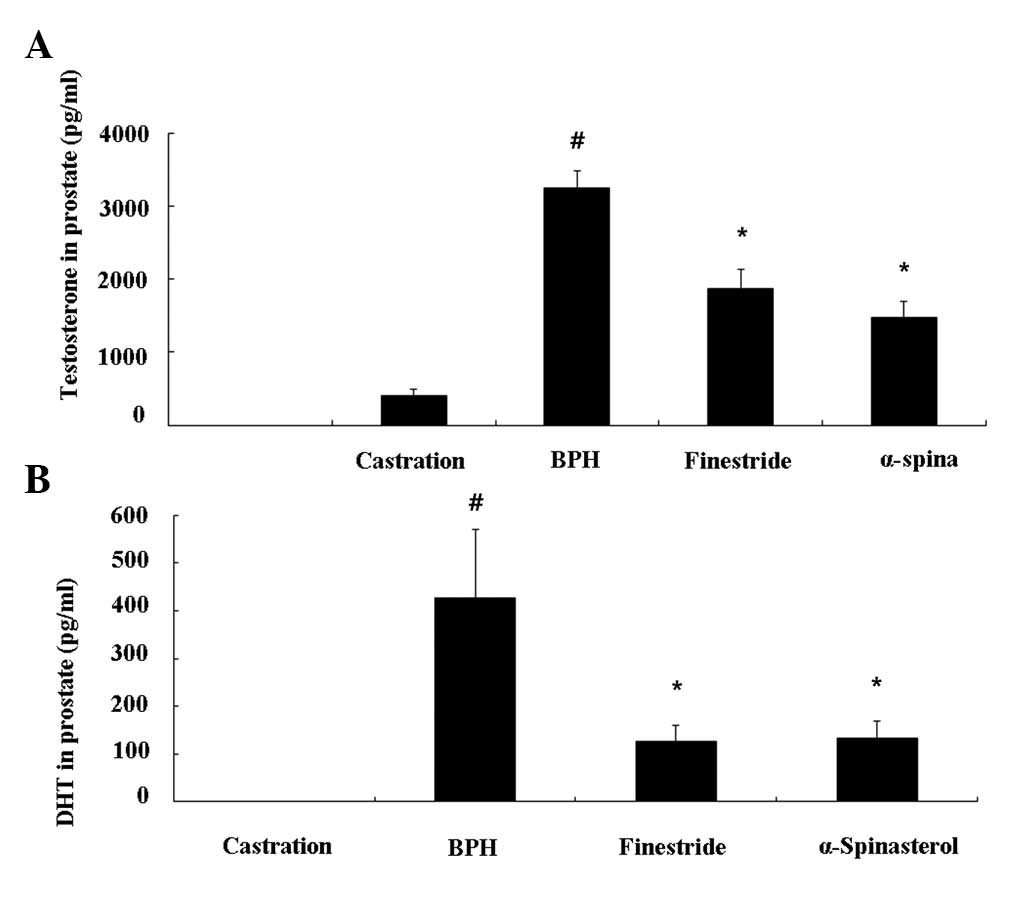α‑spinasterol from Melandrium firmum attenuates benign prostatic hyperplasia in a rat model
- Authors:
- Published online on: March 28, 2014 https://doi.org/10.3892/mmr.2014.2081
- Pages: 2362-2366
Abstract
Introduction
Benign prostatic hyperplasia (BPH) is extremely common and it is clinically characterized by prostate enlargement and lower urinary tract symptoms. Despite the enormous burden of BPH on the public health, the pathogenesis of BPH is only partially understood (1,2). It is well known that enlargement of the prostate occurs in the presence of androgens (3) and that anabolic steroids increase prostatic volume and reduce urine flow, leading to increased urinary frequency (4). The prostate is an androgen-dependent organ where testosterone and its precursors of extratesticular origin are bioactivated to the more potent dihydrotestosterone (DHT) (5). The prostate gland is generally considered a significant site of DHT formation (6). The systemic effect of endocrine activity in the prostate gland is principally DHT formation and its release to the circulation. The production of DHT increases with age, which induces the enhancement of prostate growth and hyperplasia (7). The significance of DHT is supported by clinical studies where an inhibitor of 5α-reductase was administered to males with BPH. In a number of cases, therapy with a 5α-reductase inhibitor significantly reduced the DHT level of the prostate and prostate size (8). Finasteride is widely used in the treatment of androgen-dependent diseases, specifically male pattern baldness, BPH and prostate cancer (9). Finasteride is a competitive and specific inhibitor of 5α-reductase, and has a role in inhibiting the conversion of testosterone to DHT in androgen-sensitive tissues, including the prostate and hair follicles, and therefore suppressing the serum and intraprostatic DHT concentrations (10). Conventionally, drugs, including finasteride and dutasteride, have been shown to be an effective treatment for BPH, but their use is restricted due to associated side effects, including erectile dysfunction, loss of libido, dizziness and upper respiratory tract infection (11,12).
Spinasterol is a biologically active compound isolated from the aerial parts of Aster scaber Thunb (Asteraceae), which exhibits various pharmacological activities, including antitumor, antiulcerogenic and anticarcinogenic activities (13–15). A study has demonstrated that spinasterol also has anti-inflammatory effects (16). However, there is no previous study of the possible efficacy of using α-spinasterol to treat testosterone-induced BPH model in rats. In the present study, a testosterone-induced rat model of BPH was used (17,18) and the therapeutic effects of α-spinasterol were evaluated, including its inhibition of the production of androgen hormones, such as testosterone and DHT.
Materials and methods
Plant materials containing α-spinasterol
Whole plants of Melandrium firmum Rohrbach were purchased in March 2005 from a folk medicine market, ‘Yak-ryong-si’, in Daegu and the material was confirmed taxonomically by Professor Ki-Hwan Bae, of Chungnam National University (Daejeon, Republic of Korea). A voucher specimen (YNS-99-01) was preserved at the College of Pharmacy, Yeungnam University (Gyeongsan, North Gyeongsang).
Instruments and reagents
Melting points were measured using Fisher-Johns melting point apparatus (Thermo Fisher Scientific Co., St. Louis, MO, USA) and they were uncorrected. Fourier transform-infrared spectroscopy (FT-IR) spectra were recorded using a JASCO FT-IR 300E spectrophotometer (Jasco, Tokyo, Japan). Nuclear magnetic resonance (NMR) spectra were recorded with a Bruker 250 MHz (DMX 250) spectrometer (Bruker, Rheinstetten, Germany) using a standard Bruker pulse program. The samples were dissolved in pyridine-d5 and chemical shifts were reported in parts per million downfield of tetramethylsilane. The electrospray ionization (ESI) mass spectrometry (MS) spectrum was measured using an LCQ advantage-trap mass spectrometer (Thermo Finnigan, San Jose, CA, USA) equipped with an ESI source. Stationary phases for column (silica gel 60, 70–230 and 270–400 mesh) and thin layer chromatography plates (silica gel 60 F254 and RP-18 F254) were purchased from Merck KGaA (Darmstadt, Germany). Spots were detected under ultraviolet radiation and by spraying with 10% H2SO4, followed by heating. All other chemicals and solvents were of analytical grade and used without further purification.
Extraction and isolation
Whole plants of Melandrium firmum Rohrbach (10.0 kg) were extracted three times with 80% MeOH (20 liter) under reflux for 12 h, then filtered and concentrated to yield the MeOH extract (550.0 g). The MeOH extract was suspended in H2O and extracted with hexane, EtOAc and then BuOH to yield the hexane- (75.9 g), EtOAc- (47.4 g), and BuOH-soluble fractions (97.0 g), respectively. The hexane-soluble fraction (50.0 g) was subjected to column chromatography with silica gel (60×12 cm, silica gel 70–230 mesh) and eluted using a stepwise gradient of hexane and EtOAc (100:1→1:1) to yield 32 subfractions. Fraction 14 (2.5 g) was loaded onto a silica gel column (4×50 cm, silica gel 70–230 mesh) and eluted with hexane: EtOAc (50:1-1:1) to give compound 1 (300 mg). The chemical structure of the isolated compound was determined by the comparison of physicochemical and spectral data with published values.
α-spinasterol (1): Colorless crystals, melting point: 171–173°C; IR νmax (KBr)/cm: 3,251 (OH), 1,676 (C=C stretch), 1,471 (CH2), 1,371 (CH3); 1H-NMR (250 MHz, pyridine-d5) δ: 5.18 (1H, dd, J=15.0, 8.7 Hz, H-22), 5.14 (1H, t, J=4.0 Hz, H-7), 5.08 (1H, dd, J=15.0, 8.7 Hz, H-23), 3.84 (1H, m, H-3), 1.06 (3H, d, J=6.5 Hz, CH3-21), 0.87 (3H, d, J=6.8 Hz, CH3-26), 0.85 (3H, d, J=6.5 Hz, CH3-27), 0.82 (3H, s, CH3-19), 0.59 (3H, s, CH3-18); 13C-NMR (62.5 MHz, pyridine-d5) δ: 139.6 (C-8), 138.6 (C-22), 129.6 (C-23), 117.9 (C-7), 71.0 (C-3), 55.9 (C-17), 55.3 (C-14), 51.3 (C-24), 49.7 (C-9), 43.4 (C-13), 41.1 (C-20), 40.5 (C-5), 39.6 (C-12), 38.9 (C-4), 37.6 (C-25), 37.5 (C-1), 34.4 (C-10), 32.1 (C-2), 29.5 (C-6), 28.2 (C-16), 25.6 (C-28), 23.3 (C-15), 21.8 (C-11), 21.5 (C-26), 21.2 (C-21), 19.1 (C-27), 13.2 (C-18), 12.4 (C-29), 12.1 (C-19). Fast atom bombardment-MS m/z 412 [M]+.
Animals
Male 12-week-old Wistar-Unilever rats weighing 250–350 g (Central Lab. Animal, Inc., Seoul, Korea) were housed in a room maintained at 18–23°C and with a relative humidity of 40–60% and an alternating 12 h light/dark cycle. The rats were fed a standard laboratory diet with water ad libitum. All experimental procedures were conducted in accordance with the NIH Guidelines for the Care and Use of Laboratory Animals, and animal handling followed the guidelines of the National Animal Welfare Law of Korea.
Castration procedure
Following a week of acclimatization, to prevent the influence of intrinsic testosterone, rats in all groups were castrated three days prior to the beginning of the experiments. All the animals were anesthetized by intraperitoneal injection of pentobarbital. Castration involved removal of the testicles and the epididymal fat through the scrotal sac, following a previously described method (19). The spermatic cord and blood vessels were ligated with 3-0 sutures and resected.
Induction of BPH and treatments
The rats were randomly divided into five groups (n=8) following castration and a week of acclimatization. Experimental groups 2–5 had BPH induced via daily subcutaneous injections for four weeks with testosterone propionate (TP; 3 mg/kg) dissolved in corn oil. The animals in the experimental groups received phosphate-buffered saline (PBS), finasteride (positive control, 10 mg/kg), and α-spinasterol (5 mg/kg) by gavage during the four weeks of TP injection. The negative control groups were orally administered PBS and received daily subcutaneous injections of corn oil for four weeks. Finasteride was used for the treatment of BPH, since it is a well-known 5α-reductase inhibitor. The effective dose of finasteride was based on previous reports. The body weight was measured weekly during the experiment. The application volume was calculated in advance, based on the most recently recorded body weight of individual animals.
Following the final treatment and overnight fasting, all animals were anesthetized with pentobarbital. The blood samples were drawn from the caudal vena cava. The serum was separated by centrifugation for 10 min at 200 × g and stored at −80°C. Whole prostates were immediately removed, weighed and their relative organ weight was calculated as the ratio of prostate to body weight. The percentage of inhibition of prostate to relative organ weight by α-spinasterol was calculated as previously described (20). Sections of the ventral prostate lobe were fixed with 10% buffered formalin and embedded in paraffin for histological analysis. The remaining sections of the prostates were stored at −80°C to evaluate hormone levels.
Homogenate preparation
Prostate tissue was homogenized (1/10 w/v) in a tissue lysis/extraction reagent containing protease inhibitors (Sigma, St. Louis, MO, USA) using a homogenizer (IKA, Staufen, Germany). Homogenates were centrifuged at 12,000 × g for 25 min at 4°C, and protein concentrations in the supernatant fractions were determined using a Bradford reagent (Bio-Rad, Hercules, CA, USA).
Measurements of testosterone and DHT in serum and prostate
The levels of testosterone and DHT in the serum and prostate were measured by an enzyme-linked immunosorbent assay. DHT kits were purchased from ALPCO Diagnostics (Salem, NH, USA) and testosterone kits were obtained from Cayman (Ann Harbor, MI, USA). The values are expressed per mg protein in the prostate and per ml in the serum.
Histopathological examination
To assess morphological changes in the prostate, the tissue was embedded in paraffin, cut into 4-μm thick sections and stained with hematoxylin and eosin solution (hematoxylin, Sigma MHS-16, and eosin, Sigma HT110-1-32). The tissues were mounted, placed under a coverslip using Dako mounting medium (Dakocytomation, Denmark, CA, USA) and examined microscopically (Olympus BX51; Olympus, Tokyo, Japan).
Statistical analysis
Data are expressed as the mean ± standard deviation. Statistical significance was determined using Student’s two-tailed t-test to compare independent means with Microsoft Excel (Microsoft, London, UK). P<0.01 or P<0.05 were considered to indicate a statistically significant difference.
Results
Effect of α-spinasterol on prostate weight
The relative prostate weights of TP-induced BPH animals were significantly higher compared with the negative control group. The body weight of animals treated with α-spinasterol was not significantly different from that of BPH animals (Fig. 1A). However, a significant reduction in the relative prostate weight was identified in animals treated with α-spinasterol when compared with the TP-induced BPH group (Fig. 1B).
Effects of α-spinasterol on testosterone and DHT levels in the serum
The TP-induced BPH animals had significantly higher serum testosterone levels (20.80±2.63 ng/ml) compared with the negative controls (0.14±0.18 ng/ml). However, animals treated with α-spinasterol (10.53±2.39 ng/ml, P<0.05) had significantly lower serum testosterone levels compared with TP-induced BPH animals (Fig. 2A). The DHT level in animals treated with α-spinasterol (14.74±2.38 ng/ml, P<0.05) was also significantly lower compared with TP-induced BPH animals (23.95±3.74 ng/ml, P<0.01) (Fig. 2B).
Effect of α-spinasterol on testosterone and DHT levels in the prostate
The TP-induced BPH animals had higher levels of prostate testosterone (3.25±0.23 ng/ml, P<0.01) and DHT (426.01±144.05 pg/ml, P<0.01) compared with the castrated group. The group treated with finasteride had significantly lower testosterone levels (1.87±0.27 ng/ml, P<0.01) and DHT levels (126.22±34.66 pg/ml, P<0.01) compared with BPH animals. As with the finasteride-treated group, animals treated with α-spinasterol had significantly lower testosterone (1.47±0.27 ng/ml, P<0.01) and DHT levels (133.31±35.27 pg/ml, P<0.01) compared with BPH animals (Fig. 3A and 3B).
Effects of α-spinasterol on the histomorphology of prostate tissue
The epithelial cell layers of the prostate were larger in TP-induced BPH animals compared with the negative controls. Notably, this histological analysis revealed that administration of α-spinasterol marginally altered the histoarchitecture of rats with BPH (Fig. 4).
Discussion
In the present study, a rat model was used to examine the effect of α-spinasterol isolated from Melandrium firmum Rohrbach on the progression of induced prostatic epithelial hyperplasia. The results demonstrated that relative prostate weight, androgen (DHT and testosterone) levels in prostate and serum, and histopathological changes associated with prostatic hyperplasia were significantly reduced by administration of α-spinasterol.
The reduction of prostate weight following the administration of α-spinasterol in the present study may be due to decreased levels of DHT and testosterone. According to previous studies, testosterone and DHT exhibit key role in the development of the male reproductive organs, and these hormones are commonly associated with BPH (21,22). Aging leads to excessive production of DHT, which causes the development and exacerbation of BPH (21). The relative prostatic weight of animals with BPH is significantly increased compared with a vehicle control, whereas the relative prostatic weight is reduced in animals treated with finasteride or lauric/myristic acid (20).
The results of the present study were consistent with the histopathological examination of prostate tissue. BPH animals exhibited glandular hyperplasia in the prostate, whereas animals treated with α-spinasterol demonstrated only mild glandular hyperplasia. Therefore, these findings and the results of the hormone examination indicate that α-spinasterol is effective in the treatment of BPH.
α-spinasterol also decreased the levels of testosterone and DHT in serum and prostate gland. These findings, and the results of the relative weight and histopathological examination of prostates, indicate that α-spinasterol inhibits the development of BPH in rats, and these effects are closely associated with a reduction in DHT level. Therefore, higher serum and prostate DHT levels may be associated with a larger prostate volume and a higher prevalence of BPH.
In conclusion, oral administration of α-spinasterol in a BPH rat model significantly decreased prostate size, prostatic hyperplasia and DHT levels in the serum and prostate. This information may provide an improved understanding of the pathogenesis of age-dependent conditions, including BPH. In addition, it may aid in the identification of improved targets and the development of more specific therapeutic agents to treat prostate conditions. The results of the present study indicate that α-spinasterol may be a useful agent in BPH treatment.
Acknowledgements
This study was supported by an ‘Evidence-based medicine for herbal formulae’ grant from the Korea Institute of Oriental Medicine.
References
|
Parsons JK and Kashefi C: Physical activity, benign prostatic hyperplasia, and lower urinary tract symptoms. EurUrol. 53:1228–1235. 2008.PubMed/NCBI | |
|
Roehrborn CG, Siami P, Barkin J, Damião R, Gecher E, Miñana B, Mirone V, Castro R, Wilson T and Montorsi F: The influence of baseline parameters on changes in international prostate symptom score with dutasteride, tamsulosin, and combination therapy among men with symptomatic benign prostatic hyperplasia and an enlarged prostate: 2-year data from the CombAT study. Eur Urol. 55:461–471. 2009. | |
|
McConnell JD: Benign prostatic hyperplasia. Hormonal treatment Urol Clin North Am. 22:387–400. 1995. | |
|
Wemyss-Holden SA, Hamdy FC and Hastie KJ: Steroid abuse in athletes, prostatic enlargement and bladder outflow obstruction - is there a relationship? Br J Urol. 74:476–478. 1994. View Article : Google Scholar : PubMed/NCBI | |
|
Bruchovsky N, Rennie PS, Batzold FH, Goldenberg SL, Fletcher T and McLoughlin MG: Parameters of 5 alpha-reductase activity in stroma and epithelium of normal, hyperplastic, and carcinomatous human prostates. J Clin Endocrinol Metab. 67:806–816. 1998. View Article : Google Scholar : PubMed/NCBI | |
|
Thigpen AE, Silver RI, Guileyardo JM, Casey ML, McConnell JD and Russell DW: Tissue distribution and ontogeny of steroid 5 alpha-reductase isozyme expression. J Clin Invest. 92:903–910. 1993. View Article : Google Scholar : PubMed/NCBI | |
|
Carson C III and Rittmaster R: The role of dihydrotestosterone in benign prostatic hyperplasia. Urology. 61(4 Suppl 1): 2–7. 2003. View Article : Google Scholar : PubMed/NCBI | |
|
Kumar VL and Wahane VD: Current status of 5α-reductase inhibitors in the treatment of benign hyperplasia of prostate. Indian J Med Sci. 62:167–175. 2008. | |
|
De Nunzio C, Miano R, Trucchi A, Finazzi Agrò E and Tubaro A: Finasteride for prostatic disease: an updated and comprehensive review. Expert Opin Drug Metab Toxicol. 4:1561–1568. 2008.PubMed/NCBI | |
|
Steers WD: 5alpha-reductase activity in the prostate. Urology. 58(6 Suppl 1): 17–24. 2001. View Article : Google Scholar : PubMed/NCBI | |
|
Guess HA, Heyse JF and Gormley GJ: The effect of finasteride on prostatic-specific antigen in men with benign prostatic hyperplasia. Prostate. 22:31–37. 1993. View Article : Google Scholar : PubMed/NCBI | |
|
Bullock TL and Andriole GL Jr: Emerging drug therapies for benign prostatic hyperplasia. Expert Opin Emerg Drugs. 11:111–123. 2006. View Article : Google Scholar : PubMed/NCBI | |
|
Jeon GC, Park MS, Yoon DY, Shin CH, Sin HS and Um SJ: Antitumor activity of spinasterol isolated from Pueraria roots. Exp Mol Med. 37:111–120. 2005. View Article : Google Scholar : PubMed/NCBI | |
|
Klein LC Jr, Gandolfi RB, Santin JR, Lemos M, CechinelFilho V and de Andrade SF: Antiulcerogenic activity of extract, fractions, and some compounds obtained from Polygala cyparissias St Hillaire & Moquin (Polygalaceae). Naunyn-Schmiedebergs Arch Pharmacol. 381:121–126. 2010. View Article : Google Scholar : PubMed/NCBI | |
|
Villaseñor IM and Domingo AP: Anticarcinogenicity potential of spinasterol isolated from squash flowers. Teratog Carcinog Mutagen. 20:99–105. 2000.PubMed/NCBI | |
|
Zhou CC, Sun XB, Liu JY, Luo SQ and Lu CY: Anti-inflammatory effect of alpha-spinasterol. Acta Pharmaceutica Sinica. 20:257–261. 1985.(In Chinese). | |
|
Maggi CA, Manzini S, Giuliani S and Meli A: Infravesical outflow obstruction in rats: A comparison of two models. Gen Pharmacol. 20:345–349. 1989. View Article : Google Scholar : PubMed/NCBI | |
|
Scolnik MD, Servadio C and Abramovici A: Comparative study of experimentally induced benign and atypical hyperplasia in the ventral prostate of different rat strains. J Androl. 15:287–297. 1994.PubMed/NCBI | |
|
Van Coppenolle F, Le Bourhis X, Carpentier F, Delaby G, Cousse H, Raynaud JP, Dupouy JP and Prevarskaya N: Pharmacological effects of the lipidosterolic extract of Serenoa repens (Permixon) on rat prostate hyperplasia induced by hyperprolactinemia: comprison with finasteride. Prostate. 43:49–58. 2000. | |
|
VeereshBabu SV, Veeresh B, Patil AA and Warke YB: Lauric acid and myristic acid prevent testosterone induced prostatic hyperplasia in rats. Eur J Pharmacol. 626:262–265. 2010. View Article : Google Scholar : PubMed/NCBI | |
|
Miller J and Tarter TH: Combination therapy with dutasteride and tamulosin for the treatment of symptomatic enlarged prostate. Clin Interv Aging. 4:251–258. 2009.PubMed/NCBI | |
|
Andriole G, Bruchovsky N, Chung LW, Matsumoto AM, Rittmaster R, Roehrborn C, Russell D and Tindall D: Dihydrotestosterone and the prostate: the scientific rationale for 5alpha-reductase inhibitors in the treatment of benign prostatic hyperplasia. J Urol. 172:1399–1403. 2004. View Article : Google Scholar : PubMed/NCBI |













